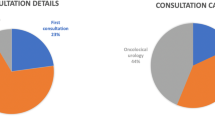Abstract
Background
Post-liver transplantation care is limited to tertiary care centers. Concentration at expert centers leads to high-volume clinics with long wait times and decreased accessibility.
Aim
To assess whether telemedicine can be utilized to overcome barriers to care while sustaining strong patient–physician relationships.
Methods
The Patient Satisfaction Questionnaire-18, Telemedicine Satisfaction Questionnaire, and Health Utilization Questionnaire were used to assess patient satisfaction and healthcare utilization among patients who received care via video connection (telemedicine group) and in clinic (control group). Propensity matching was performed. Scores for questionnaires were reported as mean and standard deviations (SD) and were compared by one-way multivariate analysis of variance and one-way analysis of variance.
Results
There were 21 matched telemedicine patients in our study. Overall mean age (± SD) was 51 (± 5.62) years and 52 (± 6.12) years for telemedicine group and control group, respectively. General patient satisfaction was similar between the two groups (p = 0.89). While telemedicine patients were just as satisfied with communication and interpersonal approach compared to clinic patients, they experienced significantly less commute (p < 0.0001) and waiting (p < 0.0001) times. Given ease of using telemedicine without compromising patient–physician interaction, 90% (19/21) of the telemedicine patients opted to use the service again.
Conclusion
Telemedicine appeared to be both a time and cost-saving alternative to clinic follow-up without compromise of the valuable patient–physician relationship. Telemedicine has the potential to improve clinic flow, reduce wait times, and decrease costs for liver transplant recipients.



Similar content being viewed by others
References
Kullgren JT, McLaughlin CG, Mitra N, Armstrong K. Nonfinancial barriers and access to care for U.S. adults. Health Serv Res. 2012;47:462–485.
Douthit N, Kiv S, Dwolatzky T, Biswas S. Exposing some important barriers to health care access in the rural USA. Public Health. 2015;129:611–620.
Siegel CA. Transforming gastroenterology care with telemedicine. Gastroenterology. 2017;152:958–963.
Arora S, Kalishman S, Thornton K, et al. Expanding access to hepatitis C virus treatment—extension for Community Healthcare Outcomes (ECHO) project: disruptive innovation in specialty care. Hepatology. 2010;52:1124–1133.
Koehler F, Winkler S, Schieber M, et al. Impact of remote telemedical management on mortality and hospitalizations in ambulatory patients with chronic heart failure: the telemedical interventional monitoring in heart failure study. Circulation. 2011;123:1873–1880.
Sengpiel J, Fuehner T, Kugler C, Avsar M, Bodmann Boemke A, Gottlieb J. Use of telehealth technology for home spirometry after lung transplantation: a randomized controlled trial. Progr Transplant. 2010;20:310–317.
Olson CA, Thomas JF. Telehealth. Adv Pediatr. 2017;64:347–370.
Dullet NW, Geraghty EM, Kaufman T, et al. Impact of a university-based outpatient telemedicine program on time savings, travel costs, and environmental pollutants. Value Health. 2017;20:542–546.
Polinski JM, Barker T, Gagliano N, Sussman A, Brennan TA, Shrank WH. Patients’ satisfaction with and preference for telehealth visits. J Gen Intern Med. 2016;31:269–275.
de la Torre-Díez I, López-Coronado M, Vaca C, Aguado JS, de Castro C. Cost-utility and cost-effectiveness studies of telemedicine, electronic, and mobile health systems in the literature: a systematic review. Telemed E-Health. 2015;21:81–85.
Telehealth. Your medicare coverage website. https://www.medicare.gov/coverage/telehealth. Accessed November 14, 2018.
Marshall GN, Hays RD. the patient satisfaction questionnaire short form (PSQ-18). Rand. 1994;. https://doi.org/10.1111/j.1525-1497.2004.30059.x.
Grogan S, Conner M, Norman P, Willits D, Porter I. Validation of a questionnaire measuring patient satisfaction with general practitioner services. Qual Health Care. 2000;9:210–215.
Thayaparan AJ, Mahdi E. The patient satisfaction questionnaire short form (PSQ-18) as an adaptable, reliable, and validated tool for use in various settings. Med Educ Online. 2013;18:3–4.
Yip MP, Chang AM, Chan J, MacKenzie AE. Development of the Telemedicine Satisfaction Questionnaire to evaluate patient satisfaction with telemedicine: a preliminary study. J Telemed Telecare. 2003;9:46–50.
Westra I, Niessen FB. Implementing real-time video consultation in plastic surgery. Aesthet Plast Surg. 2015;39:783–790.
Stewart RF, Kroth PJ, Schuler M, Bailey R. Do electronic health records affect the patient–psychiatrist relationship? A before & after study of psychiatric outpatients. BMC Psychiat. 2010;8:3.
Barber EL, Bensen JT, Snavely AC, Gehrig PA, Doll KM. Who presents satisfied? Non-modifiable factors associated with patient satisfaction among gynecologic oncology clinic patients. Gynecol Oncol. 2016;142:299–303.
Daniel H, Sulmasy LS. Policy recommendations to guide the use of telemedicine in primary care settings: an american college of physicians position paper. Ann Intern Med. 2015;163:787. https://doi.org/10.7326/M15-0498.
Otten E, Birnie E, Ranchor AV, Van Langen IM. Telegenetics use in presymptomatic genetic counselling: patient evaluations on satisfaction and quality of care. Eur J Hum Genet. 2016;24:513–520. https://doi.org/10.1038/ejhg.2015.164.
Zilliacus EM, Meiser B, Lobb EA, et al. Are videoconferenced consultations as effective as face-to-face consultations for hereditary breast and ovarian cancer genetic counseling? Genet Med. 2011;13:933–941.
Author information
Authors and Affiliations
Contributions
SS and LBL were involved in study concept and design; LBL, HKR, MRV, TD, and KGM drafted the manuscript; SS and TSD were involved in critical revision of the manuscript for important intellectual content; SS was involved in study supervision.
Corresponding author
Ethics declarations
Conflict of interest
The authors of this manuscript have no conflicts of interest to disclose.
Rights and permissions
About this article
Cite this article
Le, L.B., Rahal, H.K., Viramontes, M.R. et al. Patient Satisfaction and Healthcare Utilization Using Telemedicine in Liver Transplant Recipients. Dig Dis Sci 64, 1150–1157 (2019). https://doi.org/10.1007/s10620-018-5397-5
Received:
Accepted:
Published:
Issue Date:
DOI: https://doi.org/10.1007/s10620-018-5397-5




